Reflective Essay on Leadership: Personal Experiences and Theories
VerifiedAdded on 2020/05/16
|6
|2891
|133
Essay
AI Summary
This reflective essay explores the author's journey in leadership, starting from their early experiences as a manager in 1999. The essay details the author's leadership style, emphasizing teamwork, motivation, and consistent treatment of team members. It then delves into various leadership theories, including trait theory, style approach, skills method, situational approach, contingency theory, path-goal leadership, leader-member exchange theory, and cultural leadership. The author reflects on how these theories relate to their personal leadership style, identifying themselves as an eclectic leader who integrates different approaches. The essay further outlines areas for leadership enhancement, such as applying correction, taking initiative, adapting to surroundings, inspiring others, resolving conflict, and active listening. The author emphasizes the importance of building a strong team, fostering open communication, and promoting ethical leadership. They highlight practical steps to implement these concepts, including prioritizing cultural considerations and ethical labor practices within a company. Overall, the essay provides a comprehensive reflection on leadership development, combining personal experiences with theoretical frameworks and practical applications.
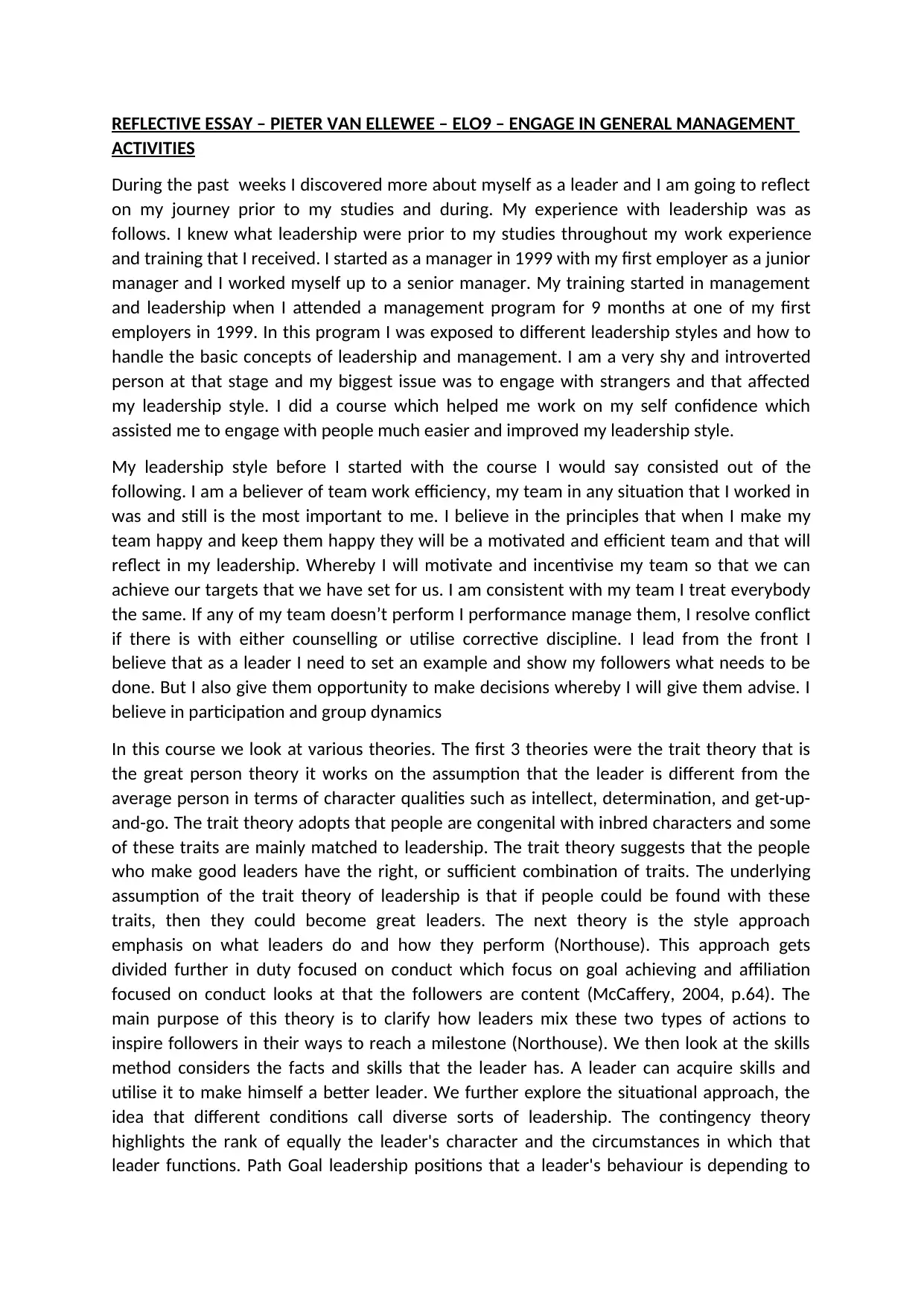
REFLECTIVE ESSAY – PIETER VAN ELLEWEE – ELO9 – ENGAGE IN GENERAL MANAGEMENT
ACTIVITIES
During the past weeks I discovered more about myself as a leader and I am going to reflect
on my journey prior to my studies and during. My experience with leadership was as
follows. I knew what leadership were prior to my studies throughout my work experience
and training that I received. I started as a manager in 1999 with my first employer as a junior
manager and I worked myself up to a senior manager. My training started in management
and leadership when I attended a management program for 9 months at one of my first
employers in 1999. In this program I was exposed to different leadership styles and how to
handle the basic concepts of leadership and management. I am a very shy and introverted
person at that stage and my biggest issue was to engage with strangers and that affected
my leadership style. I did a course which helped me work on my self confidence which
assisted me to engage with people much easier and improved my leadership style.
My leadership style before I started with the course I would say consisted out of the
following. I am a believer of team work efficiency, my team in any situation that I worked in
was and still is the most important to me. I believe in the principles that when I make my
team happy and keep them happy they will be a motivated and efficient team and that will
reflect in my leadership. Whereby I will motivate and incentivise my team so that we can
achieve our targets that we have set for us. I am consistent with my team I treat everybody
the same. If any of my team doesn’t perform I performance manage them, I resolve conflict
if there is with either counselling or utilise corrective discipline. I lead from the front I
believe that as a leader I need to set an example and show my followers what needs to be
done. But I also give them opportunity to make decisions whereby I will give them advise. I
believe in participation and group dynamics
In this course we look at various theories. The first 3 theories were the trait theory that is
the great person theory it works on the assumption that the leader is different from the
average person in terms of character qualities such as intellect, determination, and get-up-
and-go. The trait theory adopts that people are congenital with inbred characters and some
of these traits are mainly matched to leadership. The trait theory suggests that the people
who make good leaders have the right, or sufficient combination of traits. The underlying
assumption of the trait theory of leadership is that if people could be found with these
traits, then they could become great leaders. The next theory is the style approach
emphasis on what leaders do and how they perform (Northouse). This approach gets
divided further in duty focused on conduct which focus on goal achieving and affiliation
focused on conduct looks at that the followers are content (McCaffery, 2004, p.64). The
main purpose of this theory is to clarify how leaders mix these two types of actions to
inspire followers in their ways to reach a milestone (Northouse). We then look at the skills
method considers the facts and skills that the leader has. A leader can acquire skills and
utilise it to make himself a better leader. We further explore the situational approach, the
idea that different conditions call diverse sorts of leadership. The contingency theory
highlights the rank of equally the leader's character and the circumstances in which that
leader functions. Path Goal leadership positions that a leader's behaviour is depending to
ACTIVITIES
During the past weeks I discovered more about myself as a leader and I am going to reflect
on my journey prior to my studies and during. My experience with leadership was as
follows. I knew what leadership were prior to my studies throughout my work experience
and training that I received. I started as a manager in 1999 with my first employer as a junior
manager and I worked myself up to a senior manager. My training started in management
and leadership when I attended a management program for 9 months at one of my first
employers in 1999. In this program I was exposed to different leadership styles and how to
handle the basic concepts of leadership and management. I am a very shy and introverted
person at that stage and my biggest issue was to engage with strangers and that affected
my leadership style. I did a course which helped me work on my self confidence which
assisted me to engage with people much easier and improved my leadership style.
My leadership style before I started with the course I would say consisted out of the
following. I am a believer of team work efficiency, my team in any situation that I worked in
was and still is the most important to me. I believe in the principles that when I make my
team happy and keep them happy they will be a motivated and efficient team and that will
reflect in my leadership. Whereby I will motivate and incentivise my team so that we can
achieve our targets that we have set for us. I am consistent with my team I treat everybody
the same. If any of my team doesn’t perform I performance manage them, I resolve conflict
if there is with either counselling or utilise corrective discipline. I lead from the front I
believe that as a leader I need to set an example and show my followers what needs to be
done. But I also give them opportunity to make decisions whereby I will give them advise. I
believe in participation and group dynamics
In this course we look at various theories. The first 3 theories were the trait theory that is
the great person theory it works on the assumption that the leader is different from the
average person in terms of character qualities such as intellect, determination, and get-up-
and-go. The trait theory adopts that people are congenital with inbred characters and some
of these traits are mainly matched to leadership. The trait theory suggests that the people
who make good leaders have the right, or sufficient combination of traits. The underlying
assumption of the trait theory of leadership is that if people could be found with these
traits, then they could become great leaders. The next theory is the style approach
emphasis on what leaders do and how they perform (Northouse). This approach gets
divided further in duty focused on conduct which focus on goal achieving and affiliation
focused on conduct looks at that the followers are content (McCaffery, 2004, p.64). The
main purpose of this theory is to clarify how leaders mix these two types of actions to
inspire followers in their ways to reach a milestone (Northouse). We then look at the skills
method considers the facts and skills that the leader has. A leader can acquire skills and
utilise it to make himself a better leader. We further explore the situational approach, the
idea that different conditions call diverse sorts of leadership. The contingency theory
highlights the rank of equally the leader's character and the circumstances in which that
leader functions. Path Goal leadership positions that a leader's behaviour is depending to
Paraphrase This Document
Need a fresh take? Get an instant paraphrase of this document with our AI Paraphraser
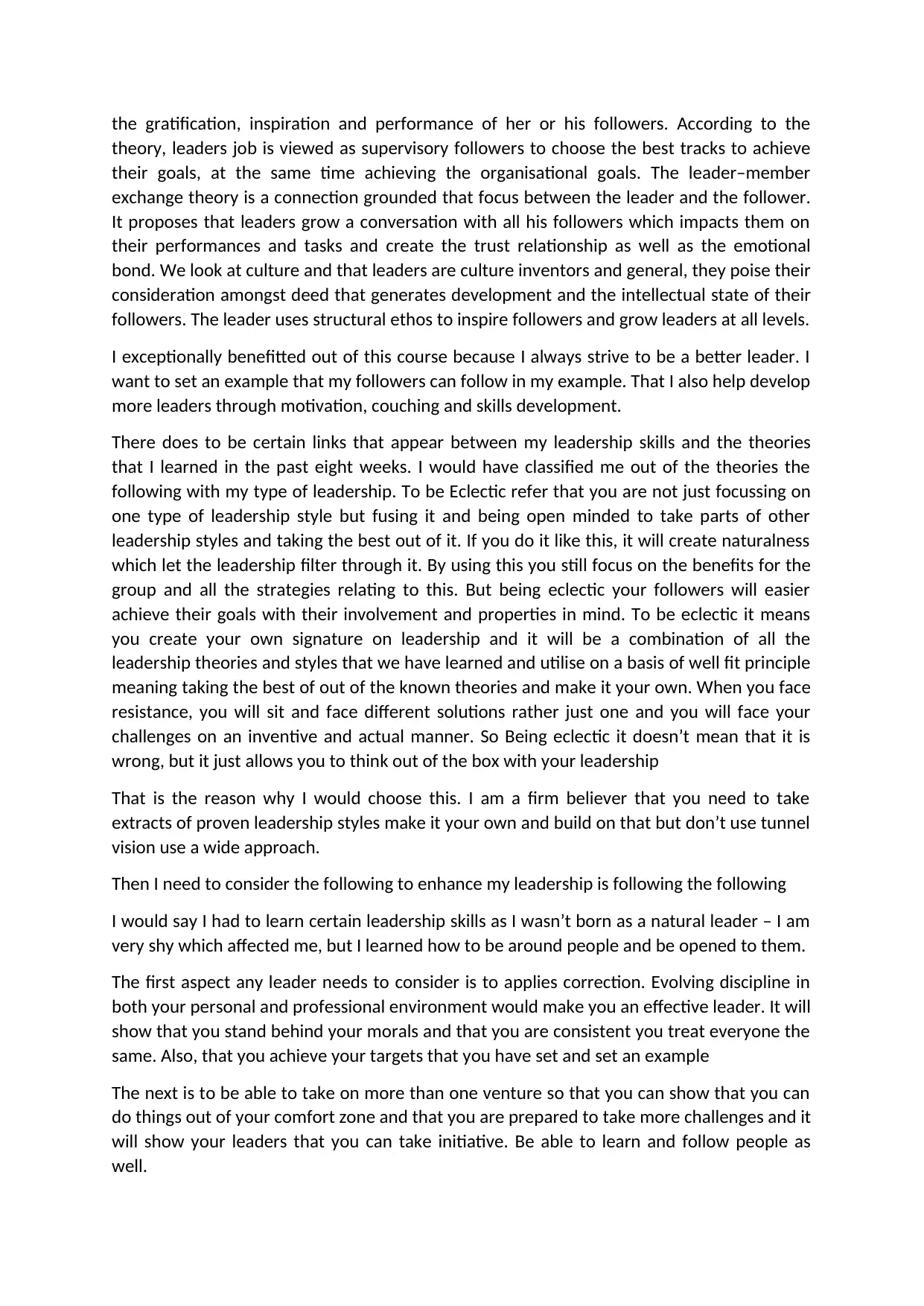
the gratification, inspiration and performance of her or his followers. According to the
theory, leaders job is viewed as supervisory followers to choose the best tracks to achieve
their goals, at the same time achieving the organisational goals. The leader–member
exchange theory is a connection grounded that focus between the leader and the follower.
It proposes that leaders grow a conversation with all his followers which impacts them on
their performances and tasks and create the trust relationship as well as the emotional
bond. We look at culture and that leaders are culture inventors and general, they poise their
consideration amongst deed that generates development and the intellectual state of their
followers. The leader uses structural ethos to inspire followers and grow leaders at all levels.
I exceptionally benefitted out of this course because I always strive to be a better leader. I
want to set an example that my followers can follow in my example. That I also help develop
more leaders through motivation, couching and skills development.
There does to be certain links that appear between my leadership skills and the theories
that I learned in the past eight weeks. I would have classified me out of the theories the
following with my type of leadership. To be Eclectic refer that you are not just focussing on
one type of leadership style but fusing it and being open minded to take parts of other
leadership styles and taking the best out of it. If you do it like this, it will create naturalness
which let the leadership filter through it. By using this you still focus on the benefits for the
group and all the strategies relating to this. But being eclectic your followers will easier
achieve their goals with their involvement and properties in mind. To be eclectic it means
you create your own signature on leadership and it will be a combination of all the
leadership theories and styles that we have learned and utilise on a basis of well fit principle
meaning taking the best of out of the known theories and make it your own. When you face
resistance, you will sit and face different solutions rather just one and you will face your
challenges on an inventive and actual manner. So Being eclectic it doesn’t mean that it is
wrong, but it just allows you to think out of the box with your leadership
That is the reason why I would choose this. I am a firm believer that you need to take
extracts of proven leadership styles make it your own and build on that but don’t use tunnel
vision use a wide approach.
Then I need to consider the following to enhance my leadership is following the following
I would say I had to learn certain leadership skills as I wasn’t born as a natural leader – I am
very shy which affected me, but I learned how to be around people and be opened to them.
The first aspect any leader needs to consider is to applies correction. Evolving discipline in
both your personal and professional environment would make you an effective leader. It will
show that you stand behind your morals and that you are consistent you treat everyone the
same. Also, that you achieve your targets that you have set and set an example
The next is to be able to take on more than one venture so that you can show that you can
do things out of your comfort zone and that you are prepared to take more challenges and it
will show your leaders that you can take initiative. Be able to learn and follow people as
well.
theory, leaders job is viewed as supervisory followers to choose the best tracks to achieve
their goals, at the same time achieving the organisational goals. The leader–member
exchange theory is a connection grounded that focus between the leader and the follower.
It proposes that leaders grow a conversation with all his followers which impacts them on
their performances and tasks and create the trust relationship as well as the emotional
bond. We look at culture and that leaders are culture inventors and general, they poise their
consideration amongst deed that generates development and the intellectual state of their
followers. The leader uses structural ethos to inspire followers and grow leaders at all levels.
I exceptionally benefitted out of this course because I always strive to be a better leader. I
want to set an example that my followers can follow in my example. That I also help develop
more leaders through motivation, couching and skills development.
There does to be certain links that appear between my leadership skills and the theories
that I learned in the past eight weeks. I would have classified me out of the theories the
following with my type of leadership. To be Eclectic refer that you are not just focussing on
one type of leadership style but fusing it and being open minded to take parts of other
leadership styles and taking the best out of it. If you do it like this, it will create naturalness
which let the leadership filter through it. By using this you still focus on the benefits for the
group and all the strategies relating to this. But being eclectic your followers will easier
achieve their goals with their involvement and properties in mind. To be eclectic it means
you create your own signature on leadership and it will be a combination of all the
leadership theories and styles that we have learned and utilise on a basis of well fit principle
meaning taking the best of out of the known theories and make it your own. When you face
resistance, you will sit and face different solutions rather just one and you will face your
challenges on an inventive and actual manner. So Being eclectic it doesn’t mean that it is
wrong, but it just allows you to think out of the box with your leadership
That is the reason why I would choose this. I am a firm believer that you need to take
extracts of proven leadership styles make it your own and build on that but don’t use tunnel
vision use a wide approach.
Then I need to consider the following to enhance my leadership is following the following
I would say I had to learn certain leadership skills as I wasn’t born as a natural leader – I am
very shy which affected me, but I learned how to be around people and be opened to them.
The first aspect any leader needs to consider is to applies correction. Evolving discipline in
both your personal and professional environment would make you an effective leader. It will
show that you stand behind your morals and that you are consistent you treat everyone the
same. Also, that you achieve your targets that you have set and set an example
The next is to be able to take on more than one venture so that you can show that you can
do things out of your comfort zone and that you are prepared to take more challenges and it
will show your leaders that you can take initiative. Be able to learn and follow people as
well.
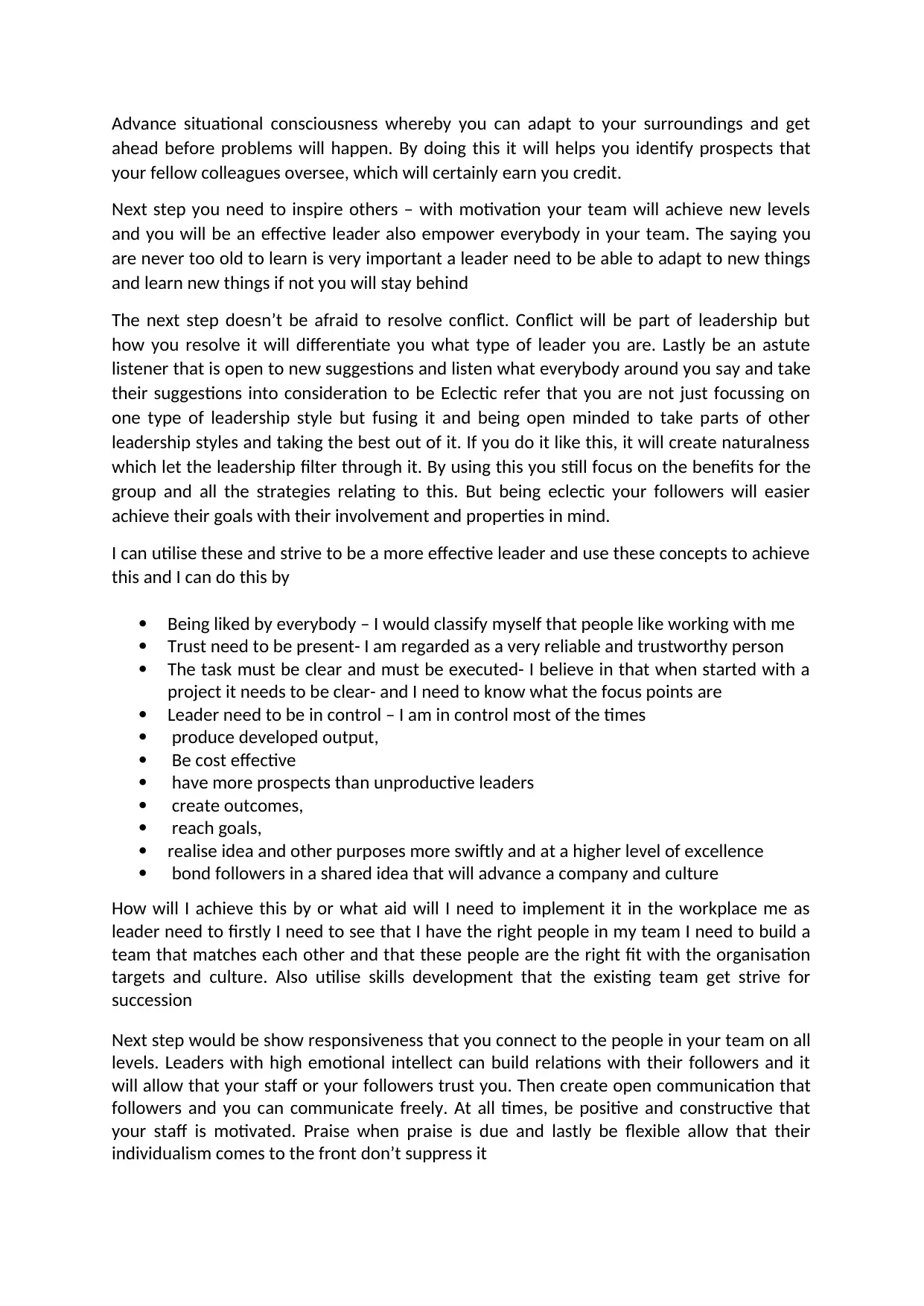
Advance situational consciousness whereby you can adapt to your surroundings and get
ahead before problems will happen. By doing this it will helps you identify prospects that
your fellow colleagues oversee, which will certainly earn you credit.
Next step you need to inspire others – with motivation your team will achieve new levels
and you will be an effective leader also empower everybody in your team. The saying you
are never too old to learn is very important a leader need to be able to adapt to new things
and learn new things if not you will stay behind
The next step doesn’t be afraid to resolve conflict. Conflict will be part of leadership but
how you resolve it will differentiate you what type of leader you are. Lastly be an astute
listener that is open to new suggestions and listen what everybody around you say and take
their suggestions into consideration to be Eclectic refer that you are not just focussing on
one type of leadership style but fusing it and being open minded to take parts of other
leadership styles and taking the best out of it. If you do it like this, it will create naturalness
which let the leadership filter through it. By using this you still focus on the benefits for the
group and all the strategies relating to this. But being eclectic your followers will easier
achieve their goals with their involvement and properties in mind.
I can utilise these and strive to be a more effective leader and use these concepts to achieve
this and I can do this by
Being liked by everybody – I would classify myself that people like working with me
Trust need to be present- I am regarded as a very reliable and trustworthy person
The task must be clear and must be executed- I believe in that when started with a
project it needs to be clear- and I need to know what the focus points are
Leader need to be in control – I am in control most of the times
produce developed output,
Be cost effective
have more prospects than unproductive leaders
create outcomes,
reach goals,
realise idea and other purposes more swiftly and at a higher level of excellence
bond followers in a shared idea that will advance a company and culture
How will I achieve this by or what aid will I need to implement it in the workplace me as
leader need to firstly I need to see that I have the right people in my team I need to build a
team that matches each other and that these people are the right fit with the organisation
targets and culture. Also utilise skills development that the existing team get strive for
succession
Next step would be show responsiveness that you connect to the people in your team on all
levels. Leaders with high emotional intellect can build relations with their followers and it
will allow that your staff or your followers trust you. Then create open communication that
followers and you can communicate freely. At all times, be positive and constructive that
your staff is motivated. Praise when praise is due and lastly be flexible allow that their
individualism comes to the front don’t suppress it
ahead before problems will happen. By doing this it will helps you identify prospects that
your fellow colleagues oversee, which will certainly earn you credit.
Next step you need to inspire others – with motivation your team will achieve new levels
and you will be an effective leader also empower everybody in your team. The saying you
are never too old to learn is very important a leader need to be able to adapt to new things
and learn new things if not you will stay behind
The next step doesn’t be afraid to resolve conflict. Conflict will be part of leadership but
how you resolve it will differentiate you what type of leader you are. Lastly be an astute
listener that is open to new suggestions and listen what everybody around you say and take
their suggestions into consideration to be Eclectic refer that you are not just focussing on
one type of leadership style but fusing it and being open minded to take parts of other
leadership styles and taking the best out of it. If you do it like this, it will create naturalness
which let the leadership filter through it. By using this you still focus on the benefits for the
group and all the strategies relating to this. But being eclectic your followers will easier
achieve their goals with their involvement and properties in mind.
I can utilise these and strive to be a more effective leader and use these concepts to achieve
this and I can do this by
Being liked by everybody – I would classify myself that people like working with me
Trust need to be present- I am regarded as a very reliable and trustworthy person
The task must be clear and must be executed- I believe in that when started with a
project it needs to be clear- and I need to know what the focus points are
Leader need to be in control – I am in control most of the times
produce developed output,
Be cost effective
have more prospects than unproductive leaders
create outcomes,
reach goals,
realise idea and other purposes more swiftly and at a higher level of excellence
bond followers in a shared idea that will advance a company and culture
How will I achieve this by or what aid will I need to implement it in the workplace me as
leader need to firstly I need to see that I have the right people in my team I need to build a
team that matches each other and that these people are the right fit with the organisation
targets and culture. Also utilise skills development that the existing team get strive for
succession
Next step would be show responsiveness that you connect to the people in your team on all
levels. Leaders with high emotional intellect can build relations with their followers and it
will allow that your staff or your followers trust you. Then create open communication that
followers and you can communicate freely. At all times, be positive and constructive that
your staff is motivated. Praise when praise is due and lastly be flexible allow that their
individualism comes to the front don’t suppress it
⊘ This is a preview!⊘
Do you want full access?
Subscribe today to unlock all pages.

Trusted by 1+ million students worldwide
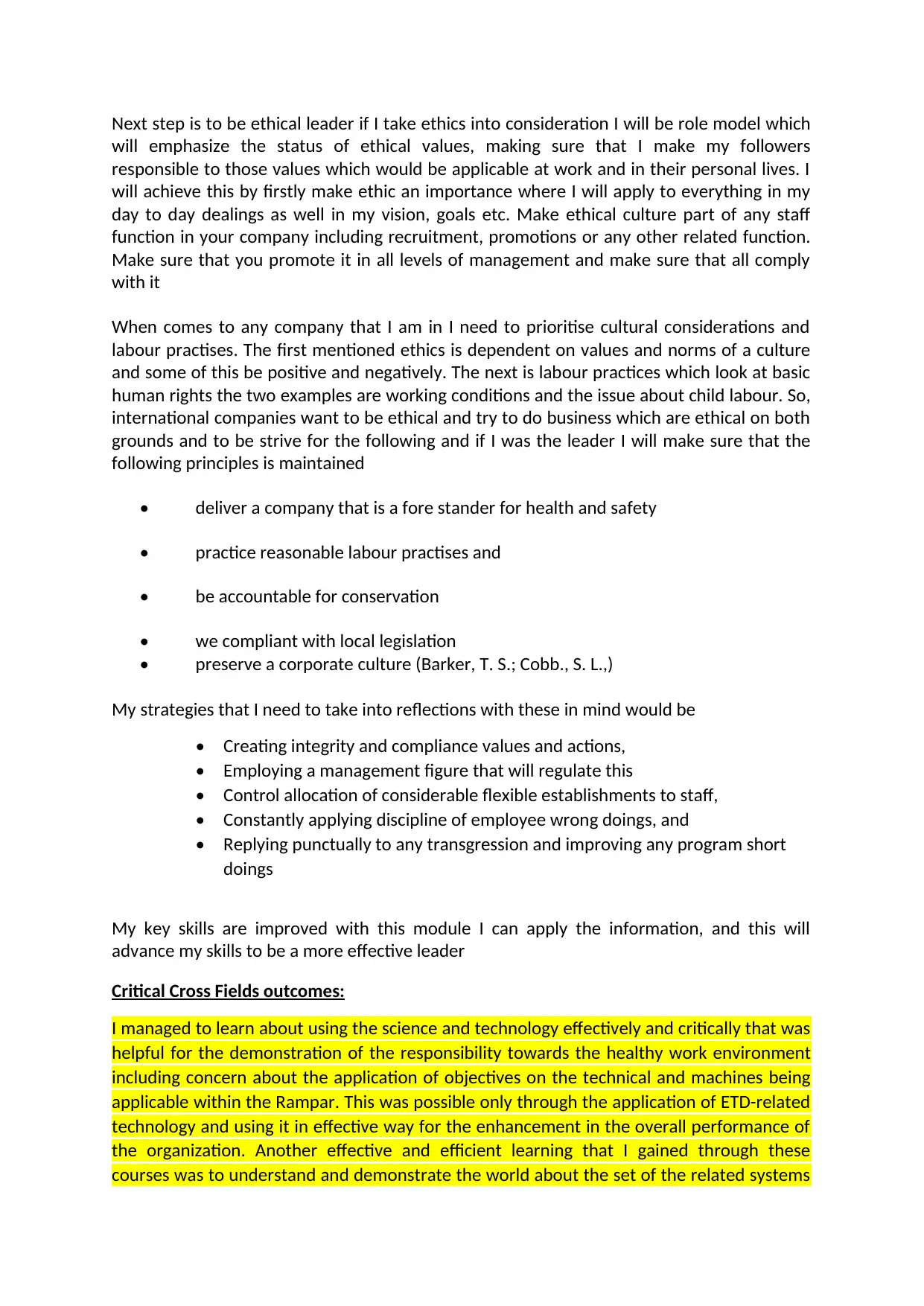
Next step is to be ethical leader if I take ethics into consideration I will be role model which
will emphasize the status of ethical values, making sure that I make my followers
responsible to those values which would be applicable at work and in their personal lives. I
will achieve this by firstly make ethic an importance where I will apply to everything in my
day to day dealings as well in my vision, goals etc. Make ethical culture part of any staff
function in your company including recruitment, promotions or any other related function.
Make sure that you promote it in all levels of management and make sure that all comply
with it
When comes to any company that I am in I need to prioritise cultural considerations and
labour practises. The first mentioned ethics is dependent on values and norms of a culture
and some of this be positive and negatively. The next is labour practices which look at basic
human rights the two examples are working conditions and the issue about child labour. So,
international companies want to be ethical and try to do business which are ethical on both
grounds and to be strive for the following and if I was the leader I will make sure that the
following principles is maintained
• deliver a company that is a fore stander for health and safety
• practice reasonable labour practises and
• be accountable for conservation
• we compliant with local legislation
• preserve a corporate culture (Barker, T. S.; Cobb., S. L.,)
My strategies that I need to take into reflections with these in mind would be
• Creating integrity and compliance values and actions,
• Employing a management figure that will regulate this
• Control allocation of considerable flexible establishments to staff,
• Constantly applying discipline of employee wrong doings, and
• Replying punctually to any transgression and improving any program short
doings
My key skills are improved with this module I can apply the information, and this will
advance my skills to be a more effective leader
Critical Cross Fields outcomes:
I managed to learn about using the science and technology effectively and critically that was
helpful for the demonstration of the responsibility towards the healthy work environment
including concern about the application of objectives on the technical and machines being
applicable within the Rampar. This was possible only through the application of ETD-related
technology and using it in effective way for the enhancement in the overall performance of
the organization. Another effective and efficient learning that I gained through these
courses was to understand and demonstrate the world about the set of the related systems
will emphasize the status of ethical values, making sure that I make my followers
responsible to those values which would be applicable at work and in their personal lives. I
will achieve this by firstly make ethic an importance where I will apply to everything in my
day to day dealings as well in my vision, goals etc. Make ethical culture part of any staff
function in your company including recruitment, promotions or any other related function.
Make sure that you promote it in all levels of management and make sure that all comply
with it
When comes to any company that I am in I need to prioritise cultural considerations and
labour practises. The first mentioned ethics is dependent on values and norms of a culture
and some of this be positive and negatively. The next is labour practices which look at basic
human rights the two examples are working conditions and the issue about child labour. So,
international companies want to be ethical and try to do business which are ethical on both
grounds and to be strive for the following and if I was the leader I will make sure that the
following principles is maintained
• deliver a company that is a fore stander for health and safety
• practice reasonable labour practises and
• be accountable for conservation
• we compliant with local legislation
• preserve a corporate culture (Barker, T. S.; Cobb., S. L.,)
My strategies that I need to take into reflections with these in mind would be
• Creating integrity and compliance values and actions,
• Employing a management figure that will regulate this
• Control allocation of considerable flexible establishments to staff,
• Constantly applying discipline of employee wrong doings, and
• Replying punctually to any transgression and improving any program short
doings
My key skills are improved with this module I can apply the information, and this will
advance my skills to be a more effective leader
Critical Cross Fields outcomes:
I managed to learn about using the science and technology effectively and critically that was
helpful for the demonstration of the responsibility towards the healthy work environment
including concern about the application of objectives on the technical and machines being
applicable within the Rampar. This was possible only through the application of ETD-related
technology and using it in effective way for the enhancement in the overall performance of
the organization. Another effective and efficient learning that I gained through these
courses was to understand and demonstrate the world about the set of the related systems
Paraphrase This Document
Need a fresh take? Get an instant paraphrase of this document with our AI Paraphraser
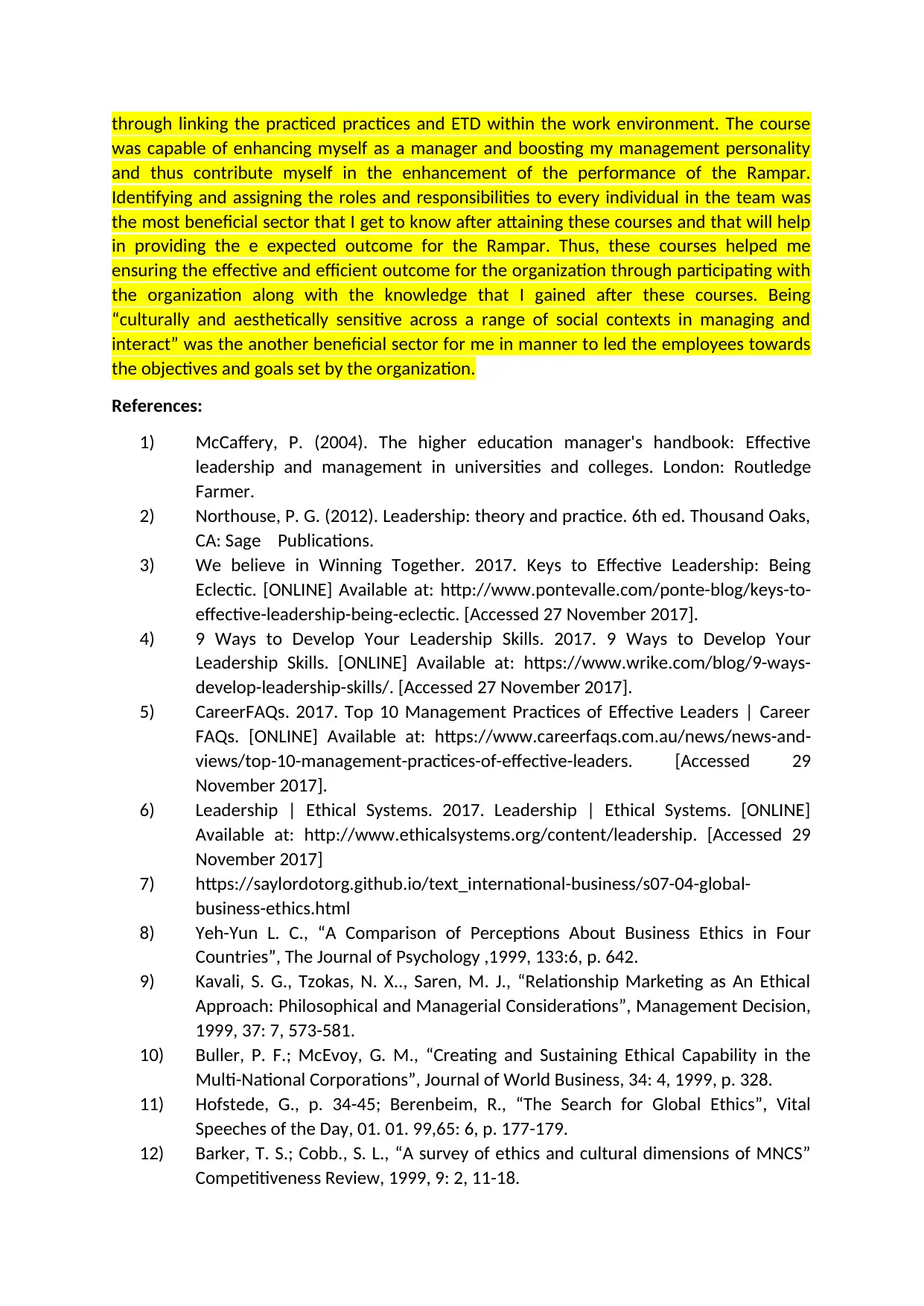
through linking the practiced practices and ETD within the work environment. The course
was capable of enhancing myself as a manager and boosting my management personality
and thus contribute myself in the enhancement of the performance of the Rampar.
Identifying and assigning the roles and responsibilities to every individual in the team was
the most beneficial sector that I get to know after attaining these courses and that will help
in providing the e expected outcome for the Rampar. Thus, these courses helped me
ensuring the effective and efficient outcome for the organization through participating with
the organization along with the knowledge that I gained after these courses. Being
“culturally and aesthetically sensitive across a range of social contexts in managing and
interact” was the another beneficial sector for me in manner to led the employees towards
the objectives and goals set by the organization.
References:
1) McCaffery, P. (2004). The higher education manager's handbook: Effective
leadership and management in universities and colleges. London: Routledge
Farmer.
2) Northouse, P. G. (2012). Leadership: theory and practice. 6th ed. Thousand Oaks,
CA: Sage Publications.
3) We believe in Winning Together. 2017. Keys to Effective Leadership: Being
Eclectic. [ONLINE] Available at: http://www.pontevalle.com/ponte-blog/keys-to-
effective-leadership-being-eclectic. [Accessed 27 November 2017].
4) 9 Ways to Develop Your Leadership Skills. 2017. 9 Ways to Develop Your
Leadership Skills. [ONLINE] Available at: https://www.wrike.com/blog/9-ways-
develop-leadership-skills/. [Accessed 27 November 2017].
5) CareerFAQs. 2017. Top 10 Management Practices of Effective Leaders | Career
FAQs. [ONLINE] Available at: https://www.careerfaqs.com.au/news/news-and-
views/top-10-management-practices-of-effective-leaders. [Accessed 29
November 2017].
6) Leadership | Ethical Systems. 2017. Leadership | Ethical Systems. [ONLINE]
Available at: http://www.ethicalsystems.org/content/leadership. [Accessed 29
November 2017]
7) https://saylordotorg.github.io/text_international-business/s07-04-global-
business-ethics.html
8) Yeh-Yun L. C., “A Comparison of Perceptions About Business Ethics in Four
Countries”, The Journal of Psychology ,1999, 133:6, p. 642.
9) Kavali, S. G., Tzokas, N. X.., Saren, M. J., “Relationship Marketing as An Ethical
Approach: Philosophical and Managerial Considerations”, Management Decision,
1999, 37: 7, 573-581.
10) Buller, P. F.; McEvoy, G. M., “Creating and Sustaining Ethical Capability in the
Multi-National Corporations”, Journal of World Business, 34: 4, 1999, p. 328.
11) Hofstede, G., p. 34-45; Berenbeim, R., “The Search for Global Ethics”, Vital
Speeches of the Day, 01. 01. 99,65: 6, p. 177-179.
12) Barker, T. S.; Cobb., S. L., “A survey of ethics and cultural dimensions of MNCS”
Competitiveness Review, 1999, 9: 2, 11-18.
was capable of enhancing myself as a manager and boosting my management personality
and thus contribute myself in the enhancement of the performance of the Rampar.
Identifying and assigning the roles and responsibilities to every individual in the team was
the most beneficial sector that I get to know after attaining these courses and that will help
in providing the e expected outcome for the Rampar. Thus, these courses helped me
ensuring the effective and efficient outcome for the organization through participating with
the organization along with the knowledge that I gained after these courses. Being
“culturally and aesthetically sensitive across a range of social contexts in managing and
interact” was the another beneficial sector for me in manner to led the employees towards
the objectives and goals set by the organization.
References:
1) McCaffery, P. (2004). The higher education manager's handbook: Effective
leadership and management in universities and colleges. London: Routledge
Farmer.
2) Northouse, P. G. (2012). Leadership: theory and practice. 6th ed. Thousand Oaks,
CA: Sage Publications.
3) We believe in Winning Together. 2017. Keys to Effective Leadership: Being
Eclectic. [ONLINE] Available at: http://www.pontevalle.com/ponte-blog/keys-to-
effective-leadership-being-eclectic. [Accessed 27 November 2017].
4) 9 Ways to Develop Your Leadership Skills. 2017. 9 Ways to Develop Your
Leadership Skills. [ONLINE] Available at: https://www.wrike.com/blog/9-ways-
develop-leadership-skills/. [Accessed 27 November 2017].
5) CareerFAQs. 2017. Top 10 Management Practices of Effective Leaders | Career
FAQs. [ONLINE] Available at: https://www.careerfaqs.com.au/news/news-and-
views/top-10-management-practices-of-effective-leaders. [Accessed 29
November 2017].
6) Leadership | Ethical Systems. 2017. Leadership | Ethical Systems. [ONLINE]
Available at: http://www.ethicalsystems.org/content/leadership. [Accessed 29
November 2017]
7) https://saylordotorg.github.io/text_international-business/s07-04-global-
business-ethics.html
8) Yeh-Yun L. C., “A Comparison of Perceptions About Business Ethics in Four
Countries”, The Journal of Psychology ,1999, 133:6, p. 642.
9) Kavali, S. G., Tzokas, N. X.., Saren, M. J., “Relationship Marketing as An Ethical
Approach: Philosophical and Managerial Considerations”, Management Decision,
1999, 37: 7, 573-581.
10) Buller, P. F.; McEvoy, G. M., “Creating and Sustaining Ethical Capability in the
Multi-National Corporations”, Journal of World Business, 34: 4, 1999, p. 328.
11) Hofstede, G., p. 34-45; Berenbeim, R., “The Search for Global Ethics”, Vital
Speeches of the Day, 01. 01. 99,65: 6, p. 177-179.
12) Barker, T. S.; Cobb., S. L., “A survey of ethics and cultural dimensions of MNCS”
Competitiveness Review, 1999, 9: 2, 11-18.
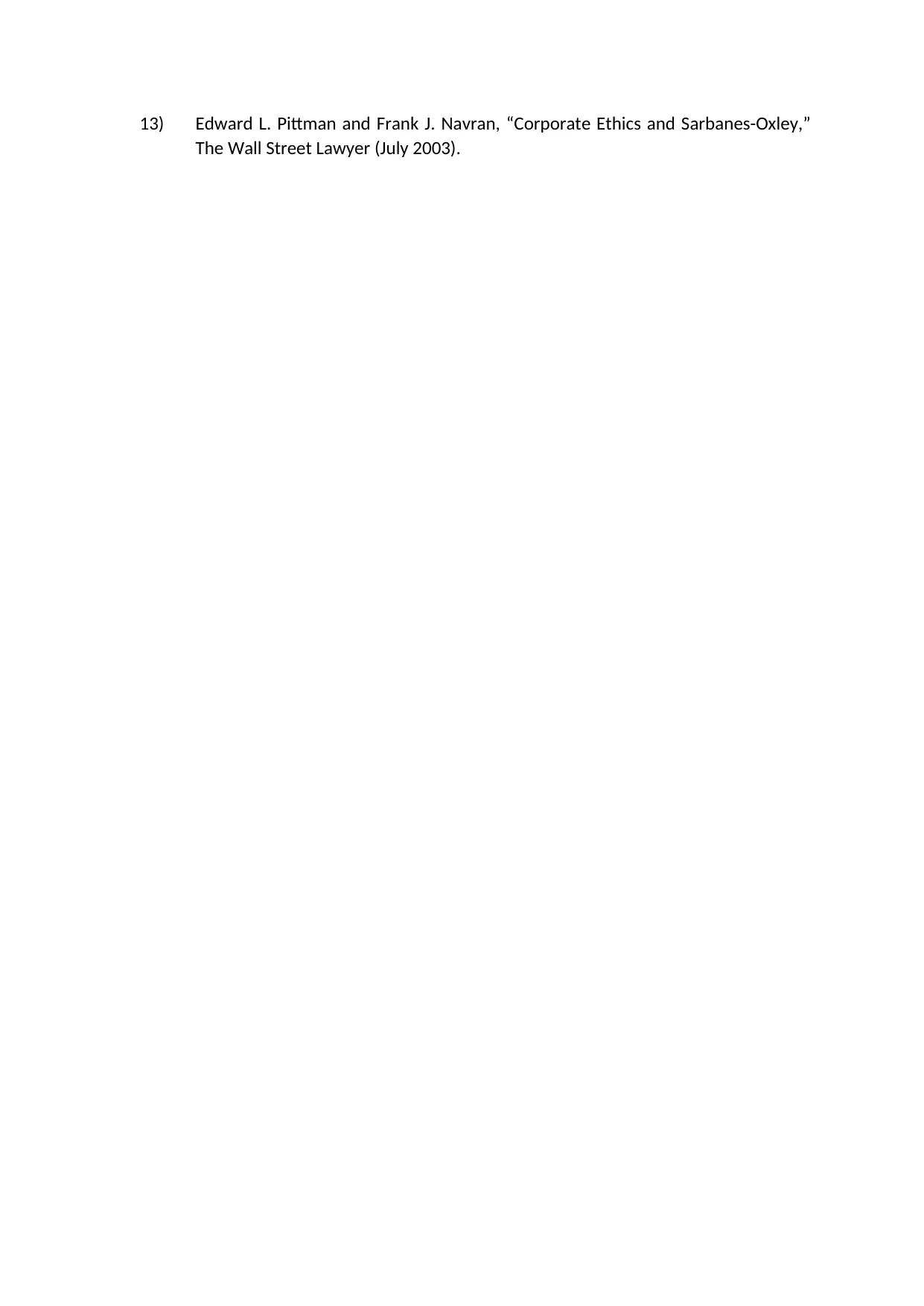
13) Edward L. Pittman and Frank J. Navran, “Corporate Ethics and Sarbanes-Oxley,”
The Wall Street Lawyer (July 2003).
The Wall Street Lawyer (July 2003).
⊘ This is a preview!⊘
Do you want full access?
Subscribe today to unlock all pages.

Trusted by 1+ million students worldwide
1 out of 6
Related Documents
Your All-in-One AI-Powered Toolkit for Academic Success.
+13062052269
info@desklib.com
Available 24*7 on WhatsApp / Email
![[object Object]](/_next/static/media/star-bottom.7253800d.svg)
Unlock your academic potential
Copyright © 2020–2025 A2Z Services. All Rights Reserved. Developed and managed by ZUCOL.



